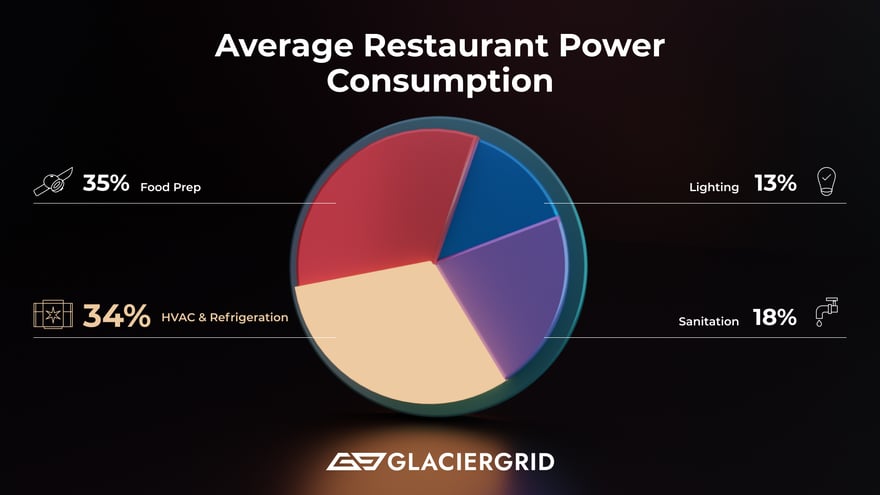Restaurant Energy Management System: What is It and Do I Need One?

Did you know restaurants are some of the most energy-intensive buildings globally? The average restaurant uses 5 - 7x times more energy per square foot than other commercial businesses. High-volume quick-service restaurants (QSRs) would even bring that number up to 10x more energy per square foot!
Out of that total energy spend, let’s focus on the two big energy burners of an average restaurant business:
- HVAC systems account for about 28% of total energy usage
- Refrigeration units account for about 6% of total energy usage
These two factors already account for about a total of 34% of your average energy consumption!
Consider that alongside your other essential energy-consuming systems:
- Food preparation: 35% of your total energy spend
- Lighting: 13%
- Sanitation equipment: 18%
So overall, your power consumption pie chart would look like this:

It’s no wonder that electricity use (and corresponding bills) continue to rise. Unfortunately, as the amount of electricity operators use rises, so do the challenges of running foodservice businesses.
However, new technology provides many solutions to optimize power consumption and, in turn, reduce your overall operating costs. This type of technology is known as an Energy Management System (EMS).
EMS and their providers promote energy efficiency by combining—
- Hardware
- Software
- Consulting
- Various control systems
All of which work in tandem to reduce a restaurant’s overall energy use.
While all that makes EMSs sound like they have a ‘premium price tag’, you don’t have to get them from an expensive third-party provider.
You can achieve incredible feats of energy-saving optimizations with just simple adjustments—all you need now is to know where to look.
But first, let’s help you evaluate your need for an EMS…
Is a restaurant Energy Management System really effective?
Optimizing your restaurant for energy efficiency is a significant undertaking. Due to the complexity of the interconnected systems found within restaurants—electricity management requires a detailed multi-pronged approach.
Because of this fact, simply purchasing a single piece of software will not produce the desired results. On the other hand, investing in an EMS provider or consultancy may not be practical for all restaurants.
While many EMS, in general, are proven effective, they may require high upfront costs and no timetable for receiving a return on investment.
If you are considering investing in a third-party Energy Management System, you’ll need to ask yourself the following questions:
Do I have the team infrastructure to respond to EMS alerts?
Before purchasing an EMS, identify which teams or individual staff will take charge of the alerting system. For smaller teams, consider monitoring only the aspects of equipment that are most important to your customer experiences, such as refrigeration and HVAC.
Can I tailor my EMS to deal with issues specific to my restaurant?
There is no one-size-fits-all solution. Ensure that the EMS system you’re eyeing offers a customized approach, providing solutions tailored to your restaurant. As much as possible, value the options to add and subtract hardware components as needed for your operation.
Is the EMS scalable?
Ensure that you can integrate the EMS into other buildings within your restaurant chain. There should also be a unified dashboard that makes it easy for you to track and analyze individual data points across the various locations.
Will the EMS ensure consistent ROI?
You must be able to financially accommodate the upfront costs of implementing an EMS and achieve ROI within a quantifiable period. In the food service industry, this should be 10% every quarter consistently.
Is the EMS user-friendly?
Non-technical personnel should be able to understand and use the system without much help from in-house maintenance personnel. As rank-and-file staff use the equipment daily, their comprehension should help facilitate proper and efficient use in standard operations.
With all these considerations in place, it’s time to tackle the next big question…
How should I start optimizing my systems for energy conservation?
Before understanding how to optimize your restaurant equipment for energy efficiency, let’s go back to that energy consumption pie chart from earlier.
Generally, energy usage can be split between front and back-of-house use cases, with back-of-house utilizing power more heavily. Some front-of-house use cases include ambient lighting and HVAC systems, while the back of the house relies heavily on ventilation, cooking, and refrigeration.
Therefore, to globally reduce energy usage, you’d need to utilize metering, maintenance, and other optimization techniques for all of the high energy-consuming equipment in your buildings.
Here are some of the most accessible and most impactful techniques you can implement now:
-
Create manual HVAC protocols
Set HVAC (Heating, Ventilation, and Air-Conditioning) temperatures based on creating procedures that ensure HVAC systems operate at appropriate levels during service and after closing.
-
Practice preventative maintenance
Ensure that you schedule monthly inspections of crucial equipment components. For your refrigeration units, these include gasket inspections, cleaning condenser coils, and replacing air filters.
-
Implement routine cleaning
Routinely clean and maintain your restaurant’s ventilation systems and lights so they can operate with superior energy efficiency.
-
Purchase new equipment as needed
Update and replace your older and aging equipment, such as coolers and lighting. You can consider using ENERGY-STAR certified appliances as they can provide your restaurant with newer and more energy-efficient models.
-
Install remote temperature monitoring systems
Temperature monitoring devices can help you discern when your cold storage equipment is running outside the food safety threshold—a clear sign of excess energy use
Temperature monitoring systems are a crucial part of your EMS since energy usage from refrigeration can fluctuate. At a point in their lifespan, refrigeration units would suddenly demand the most energy usage of any single system in a restaurant. This is partly due to the plethora of interconnected components that allow them to operate.
Because refrigerators consume vast amounts of power in the long term, it's unsurprising that their components wear down over time. At some point, your refrigeration systems may become less effective at holding a static temperature, causing increased energy consumption to compensate and operate correctly.
One major sign of increased energy consumption in refrigerators is the inability to hold the temperature threshold set on the machine's thermostat.
However, remote monitoring systems would constantly monitor your refrigeration equipment to spot these discrepancies. Thus, alerting you early to conduct much-needed maintenance that can drastically improve their overall energy efficiency and savings.
So, how can I use my restaurant's Energy Management System to impact my business positively?
With the current price and scarcity of energy, the best way to yield financial savings would be to use practical and evidence-based efforts to reduce your overall energy consumption.
According to this downloadable PDF from the Department of Energy:
“EMS can save about 5% to 25% of the total energy used. Savings vary by climate, existing building conditions, and the state of maintenance of onsite equipment.”
Further savings can accumulate unintentionally due to some of the measures introduced through Energy Management Systems and associated control systems.
For example:
The average restaurant loses 28-35% of its income annually from wasted inventory, often caused by subpar cold storage. By monitoring the temperature within your cold storage with remote temperature monitoring systems, you can take active steps to prevent your inventory from spoiling.
The same is true for equipment maintenance. Often, restaurants would delay necessary fixes to their cold storage equipment due to the inconvenience of equipment downtime and the price of repairs.
However, if you neglect to maintain your equipment for an extended period of time, it’ll start consuming excess electricity—and ultimately fail.
Spoilage prevention and energy conservation also have other positive impacts on your business, aside from financial. Energy management systems and their associated components can also help your business’s sustainability initiatives. Because saving energy reduces the number of carbon-based energy resources your restaurant uses, EMSs provide cost savings that make your energy system sustainable.
Additionally, pieces of equipment that tend to run out of threshold also may leak refrigerants, especially those nearing the end of their life—emitting about 90% of refrigerants at that point! Which are highly destructive to the environment.
What does a reliable restaurant energy management system look like?
It should help you accomplish the following:
- Accurately collect energy data
- Vigilantly detect early signs of refrigeration unit breakdown
- Provide the necessary information for you to make time-sensitive decisions, such as preventive maintenance
GlacierGrid puts check marks in all those boxes and more.
Designed to reliably perform inside your coolers, freezers, and other harsh environments, GlacierGrid LoRaWAN® temperature monitoring gives you real-time data collection and detailed insights around the clock. Allowing you and your team to optimize your systems for better energy performance and maintain your equipment, facilities, and power systems.
Everything you need in a restaurant EMS—with an extra kick:
-
Enhanced alerting
Get timely notifications by SMS, phone call, push notification, or email when equipment is out of temperature range. GlacierGrid smart alerts can help you conveniently adjust your alert settings or snooze alerts during scheduled downtime.
-
Unhindered monitoring for more uptime
GlacierGrid LoRaWAN® powered sensors have a range of 1,200+ feet, use 4G LTE instead of WiFi, and record data even during power outages.
-
Detailed and actionable reports
Create automated temperature and humidity reports with GlacierGrid’s proprietary algorithm to forecast equipment trends and make real-time facilities management decisions, whether your commercial kitchen is in a restaurant or an office building.
-
Easy to use and set up
Forget time-consuming third-party installation. GlacierGrid’s temperature monitoring system is ready to go in 10 minutes or less. GlacierGrid offers an open API so you can easily integrate data into your existing tech stack.
-
Unlimited teams and locations
GlacierGrid allows use for unlimited teams and locations—simplifying your equipment management across your multiple sites.
Is there any reason I shouldn’t have an EMS for my restaurant?
Given the diversity in food service operations, finding the right automation system to manage and optimize your energy use is up to your restaurant's specific needs.
However, no matter your restaurant’s needs, as long as cold storage plays a role in your business model—temperature monitoring is a must-have implementation.
So before you start investing large upfront sums of money in third-party Energy Management Systems—consider trying GlacierGrid.







